
With the rise in crypto popularity, the financial markets have seen an influx in decentralized applications, as well. These dApps are part of a new form of the internet, known as Web 3.0. In this Crust Network review, I’ll tell you about one of the more-interesting projects to come out of the space, in recent times.
The Crust Network crypto project positions itself as a decentralized data storage provider. It’s a unique service in a world where data storage and preservation are becoming increasingly more important by the day! With the help of its native CRU coin, the project in question aims to address said topics, in a cross-chain manner.
If you’re just starting in the field of decentralized finance, or have never accessed a single dApp before, concepts such as “decentralized data storage” and “cross-chain functionality” might sound very confusing. Worry not, since even if you’re new to crypto, I’ll tell you everything you need to know about the Crust Network crypto project, in simple terms!
Before we can get into the actual review of the service, though, we should first get a clear understanding of what it does.
Stop overpaying - start transferring money with Ogvio. Sign up, invite friends & grab Rewards now! 🎁
Pros
- Decentralized data storage & sharing
- Off-chain operations
- Suitable for individuals and developers, alike
- Store personal, Web 3.0, NFT, Metaverse-related files
- CRU token - utility and governance
- Dedicated Crust Wallet
Cons
- Steep learning curve for beginners
Table of Contents
- 1. What is Crust Network?
- 2. Crust Network Review: PROS
- 2.1. Decentralization - A Core Value of the Crust Network
- 2.2. A Secure and Trustless Way of Storing / Sharing Files
- 2.3. The CRU Token - Utility, Governance, and More
- 2.4. A Dedicated CRU Token Wallet
- 2.5. Reliable, Decentralized dApp / Website Hosting for Developers
- 2.6. Off-Chain Data Storage
- 2.7. A Solid Roadmap Ahead
- 3. Crust Network Review: CONS
- 3.1. Might be Too Complicated for Your Average Individual
- 4. Conclusions
What is Crust Network?
To put it simply, Crust is a decentralized data storage network. It’s concerned with Web 3.0, and the ecosystems present on this new form of the internet.
Probably the simplest way of how you can think of the Crust Network crypto project (albeit acknowledging that it's far from a 1:1 example) is as a decentralized Dropbox (at least as far as Crust Files are concerned). While that’s not ENTIRELY accurate, it does paint a clearer picture of what Crust is all about.
User Crust Network reviews will tell you that you may store files on the network, and share them with other individuals, yet, unlike with traditional file-sharing platforms, you are able to keep everything anonymous and decentralized.
The goal that’s present with the project is to create a decentralized Cloud ecosystem - one that would uphold the traditional values of crypto, through a data storage medium. These values would include data integrity preservation, anonymous file storing, true file ownership, and more.

Certain user Crust Network reviews might also tell you that the project in question is made up of a few different elements - the Crust Network for individuals, a dedicated area for developers (where they can create their own dApps), and a native utility token called CRU. We’ll talk about all of these concepts in the Crust Network review ahead.
Truth be told, even if you’re completely new to the world of dApps and metaverses, in general, there’s a lot of value that you can receive from the Crust Network, and the services that it provides! You don’t need to be crypto-savvy in order to value your privacy, or appreciate anonymity.
That being said, I’m getting ahead of myself - let’s take it one step at a time, and explore the actual benefits associated with Crust.
Crust Network Review: PROS
Starting off from the positive side of things, probably the most self-explanatory and obvious benefit that you’ll see mentioned in user Crust Network reviews is the fact that this is a decentralized, privacy-oriented data storage network.
Decentralization - A Core Value of the Crust Network
Decentralization refers to something not having a single governing authority. It’s arguably the most important aspect of crypto, next only to anonymity.
The concept of Web 3.0 is based entirely on this notion of a decentralized internet. Users would be able to remain anonymous with their interactions with each other, and could share sensitive information without the fear that some overarching social media giant will snoop around their business.
As I’ve pointed out a few times already in this Crust Network review, the project in question aims to become the go-to solution for sharing data - this is true both if you’re an individual looking to store a picture, or a developer who wants to create a dApp. Decentralization, in this regard, is only part of the equation. The other part consists of IPFS - specifically, Crust provides an incentive layer for IPFS nodes.

With decentralized storage, you don’t need to worry about your data being siphoned and sold off to some third-party advertisers, or that an information leak could jeopardize your identity and reveal some private information about your persona. In fact, decentralization actually adds to the security side of things, but more on that later.
In an environment like this, you would have the CRU crypto token, which would help both govern the network, as well as act as a utility tool for performing transactions within the said ecosystem. Consequently, this would eliminate the need for some sort of a compromise on your identity or personal information!

On the more technical side of things, Crust uses a consensus model called MPoW, or - Meaningful Proof of Work. It’s a unique type of trustless technology that allows the network to inspect and guarantee the work that crypto miners perform, in order to keep the network decentralized. This is done with the help of the TEE function (SGX) - a node must meet all of the specific TEE requirements, in order for its proof of work to be accepted into the network.
The above-mentioned aspect is important if you’re a developer looking to create a dApp, and are considering storing it on the Crust ecosystem. However, if you’re reading through Crust Network reviews simply to “get a feel” for the platform, it should suffice to say that the project in question views decentralization as one of its core features.
A Secure and Trustless Way of Storing / Sharing Files
As I’ve mentioned earlier in the Crust Network review, one of the big benefits that decentralization brings with itself is security - at least in theory.
A centralized institution (application, software, service, etc.) may potentially have a lot of weak points - ones that can be exploited by malicious third parties. This can be proved by simply googling all of the high-profile hacks that have happened throughout the years, and that have concerned some sort of a data integrity breach.
With a decentralized system, there are multiple (hundreds, thousands, even) nodes that are working to keep the (eco)system functional. Following that, decentralized platforms often have certain industry-standard security features in place, as well - things such as an open-source code for anyone to inspect and improve, high-end encryption, and so on.
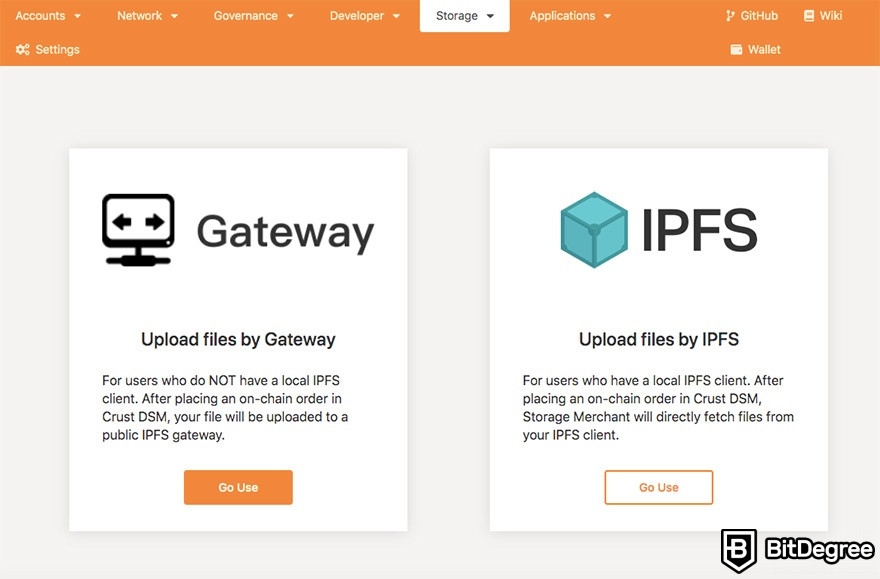
In regards to this Crust Network review, I must say - the situation isn’t at all different!
The security of the Crust Network crypto network lies in its tokens, as well as its storage resources. Same as with the MPoW technology that Crust uses to manage its resources, there’s a separate consensus mechanism in place for dealing with security issues, too - it’s called GPoS, or Guaranteed Proof of Stake.
Once again, if we were to get technical, GPoS requires nodes to provide storage proof, in order to receive their staking quota. This helps ensure that the network remains stable, and that there are no issues that would arise when it comes to storage confirmations.
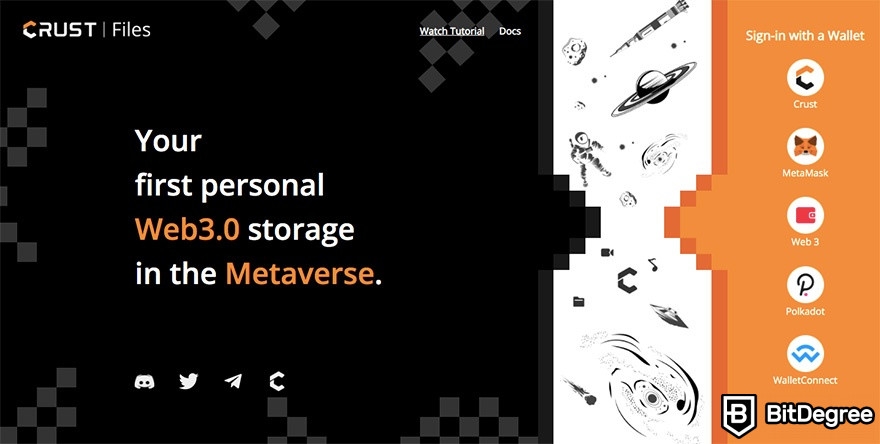
From a general standpoint, the anonymous nature of the project means that, even if there was some sort of a security breach, and your data was compromised, there would be nothing tying it back to you. That’s significant, and not something that centralized data storage providers are able to boast about!
The CRU Token - Utility, Governance, and More
I’ve already hinted at this a few times throughout this Crust Network review, but the CRU coin (rather, token - some people refer to it as a coin, for simplicity’s sake) is the main asset of the Crust Network. If you’re planning to participate in the ecosystem, and want to use the services offered by Crust, you’ll surely need to hold some CRU.
First things first, though - what is it used for?
Well, to be frank with you, the Crust Network token has a lot of different uses! For starters, among the most-important points here would be the fact that CRU is used to maintain the GPoS consensus I’ve told you about earlier. Here, individuals can become "Guarantors", and are able to stake for other nodes, thus earning a guarantee fee. Following that, the token is also used as a form of guarantee on the resource provision services.
How does this work? Well, all of the nodes need to stake CRU tokens. If they become malicious, or choose to verify false processes, they will be punished by losing out on their stake. This, in turn, ensures proper security and the above-mentioned guarantee of resource provision.
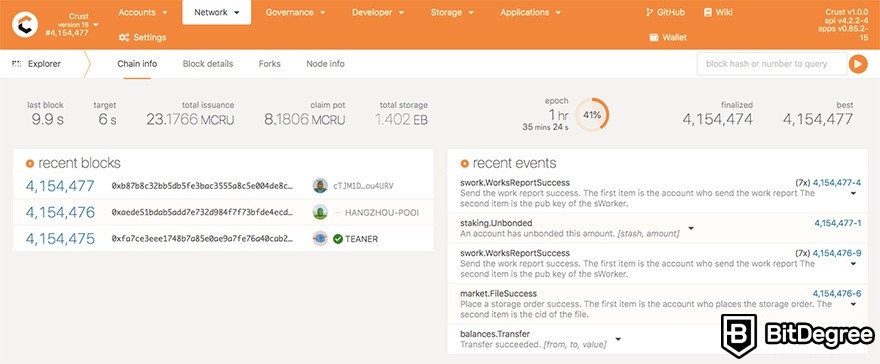
In layman’s terms, all of that means that the CRU coin is used to both secure the network, as well as maintain order when it comes to data storage resource provision. The token incentivizes third parties to provide data storage resources, while the nodes on Crust Network then work to keep the processes decentralized.
Then, you have the more-straightforward uses of the token - things like transaction fee payments and resource purchases. This makes the CRU token a direct financial asset that can be exchanged for services on the Crust Network - that’s a huge use case!
Lastly, one of the most important features of the CRU token is governance. Specifically, token holders will be able to vote on network changes and updates, as well as different improvement proposals. So, in a sense, this makes the Crust Network community a DAO - Decentralized Autonomous Organization.
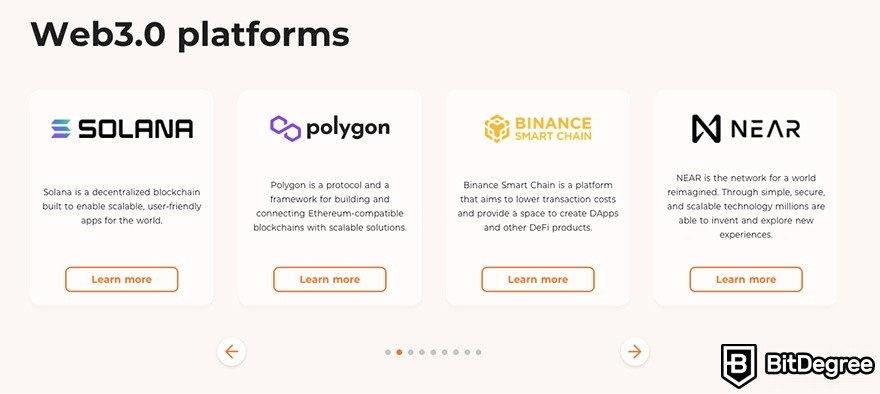
DAOs are the governing model for decentralized finance projects. Essentially, they put the power into the hands of the community behind the project - ideally, this results in more transparency, and a fair, democratic vote on changes and proposals.
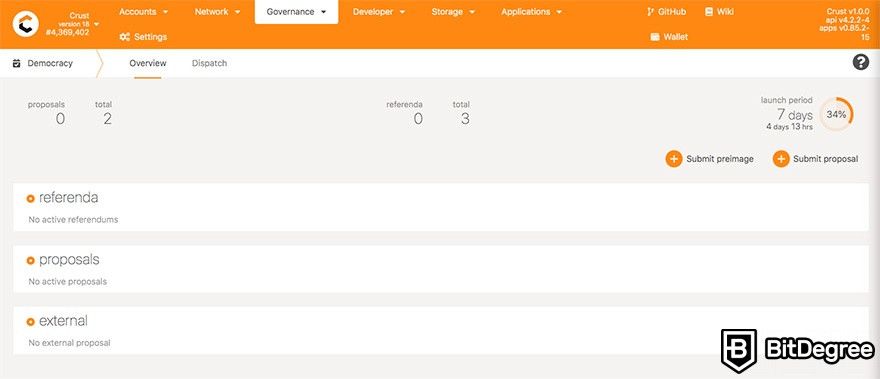
All things considered, as far as this Crust Network review is concerned, the token is a truly essential part of the Crust ecosystem! In a sense, it “ties it all together”, providing its holders with both multiple use cases, as well as a financial means to transact within the ecosystem.
What about the CRU price? How has the token performed, over time?
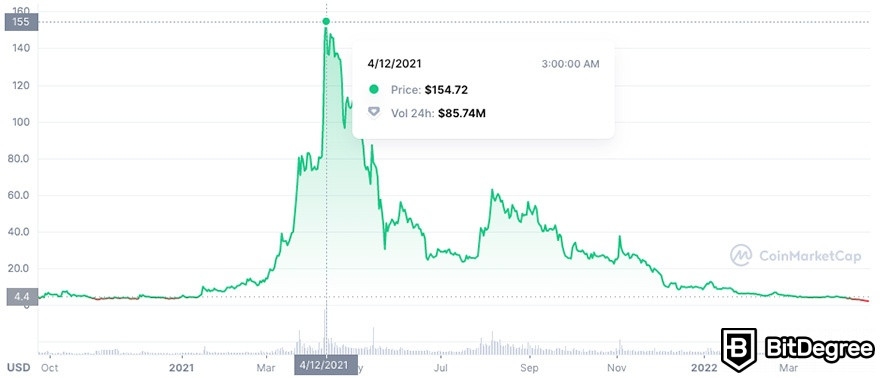
Well, to be fair, the Crust Network price graph has moved in correlation with the general market trend, over the last couple of years. In short, the CRU token started out with a price tag of around $4, and then, after around 5 months of unimpressive price movements, it started gaining traction in February 2021.
At its peak, in April 2021, a single CRU token was worth over $150! That’s almost 38 times its original price! It's worth stating, though, that this surge in CRU price is probably mainly because, when the market circulation is small, the number of nodes skyrockets, and the tokens used for guarantee are in short supply - huge demand and small supply equal in a large price tag.
As of writing this Crust Network review, though, the token is currently priced at around $2 - that’s a notable drop! However, it’s not at all that surprising, either - many crypto projects have had similar price swings, and the price of the token isn’t something that should be used to showcase the value of the project, 9 times out of 10.
With Crust, this isn't an exception. With more tokens entering the circulation on the mainnet, naturally, the price will drop, too.
Truth be told, many Crust Network coin fans are waiting for the token to take off, once again, and overtake its previous ATH!
A Dedicated CRU Token Wallet
Having discussed the Crust Network token extensively, naturally, your next question might be - where should you store all of these CRU tokens?
Well, Crust has great news for you in that regard, too - the project has a dedicated CRU token wallet.
The Crust Wallet is specifically designed for storing CRU tokens. It’s a plugin - in other words, same as with popular hot wallets such as MetaMask, you don’t need to download or install anything on your desktop - instead, the wallet will be added to your browser plugin list, and will be accessible there.
Crust themselves list three different use cases for the wallet. They are, as follows:
- Interacting with the dApps available on the Crust Network
- Managing accounts
- Transfering tokens
In essence, the wallet acts as your personal profile on the Crust Network - this is in-line with the philosophy behind decentralized finance, in general! You are able to both interact with the different dApps available on the network, as well as create decentralized applications of your own.
When it comes to token transfers, that’s somewhat self-explanatory - here, the Crust Wallet acts as any other crypto coin or token wallet, and allows you to transact with other parties. However, you should keep in mind that the wallet does NOT support CRU tokens of the ERC-20 token standard. Instead, only the CRU tokens that are based on the native mainnet of the project can be stored on it.
Now, if you’d like to install the wallet on your browser, there are basically two ways of going about it - one’s super-simple, while the other one is targeted at developers.

The “super-simple” method of going about it is just that - installing the wallet from the Chrome Web Store! You can find the app here - once you click “Add to Chrome”, and pass a few confirmation windows, the wallet will be installed, and you’ll be able to access it from your plug-in hub, on your browser. It takes just a few seconds to set up!
On the flip side, the developer-oriented method is a bit more complicated. However, I won’t cover it here - instead, I’ll be writing a dedicated tutorial on how to use and interact with the Crust Network, and talk about this alternative wallet installation method there. Once I do write the tutorial, you’ll be able to find it here.
Developers should also note that all Substrate chains are compatible with the same JSON address. You may download your backup, and then use it to log into any of the Substrate wallets on Polkadot, Kusama, and so on.
All in all, it’s awesome that Crust has a dedicated wallet for the project - user Crust Network reviews agree with that sentiment, too!
Reliable, Decentralized dApp / Website Hosting for Developers
Throughout the entirety of this Crust Network review, we’ve been focusing on how the Crust Network crypto project is useful for your average individual. However, it’s worth stating that the ecosystem has some huge benefits to offer to developers, too!
Specifically, Crust offers devs the ability to host their decentralized applications and (or) websites in a “serverless” fashion. The hosting would happen on the Crust / IPFS Network.
In doing so, developers would be able to eliminate one element from the equation - server management. With the files of your website or dApp being stored (held) by multiple nodes on the Crust Network, this would make your project readily available, while the “serverless” nature of how Crust works would allow you to focus on developing the actual dApp or site, instead of managing server issues.
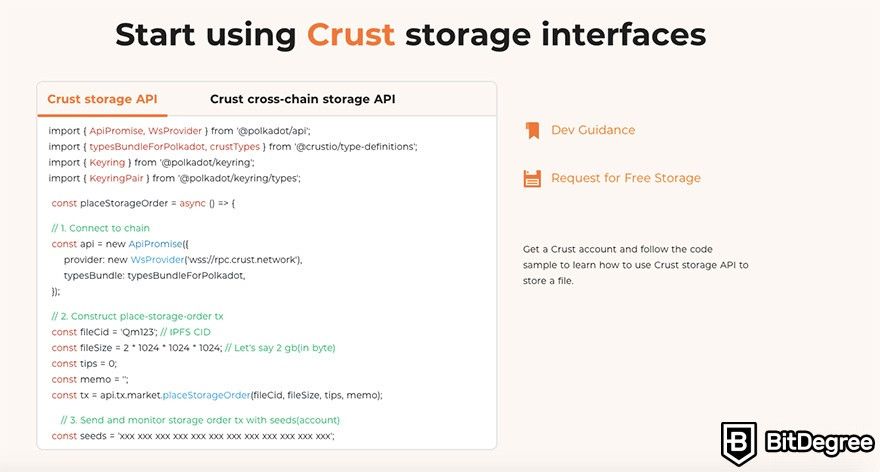
Naturally, this type of project hosting is also notable for its security and anonymity features, too. Since all transactions would take place with the help of your Crust Wallet, your identity would remain private, if you so choose to!
Security-wise, I can only go back to what we’ve already covered, earlier in the Crust Network review - with this specific type of data storage employed by Crust, your data is stored (shared) by multiple nodes, in a decentralized fashion. With DAO governance-like mechanics, this ensures full transparency, and (usually) optimal, up-to-date security.
There are also Crust Grants, too - it's a special program that rewards individuals and (or) companies that bring value to the decentralized, Web 3.0 storage ecosystem. If you're accepted into the Grant program, you will receive funding support of up to 30,000 USDT, community participation, member certification, connections, and much more. It's definitely a notable point to keep in mind!
Off-Chain Data Storage
This is that one part of the Crust Network review where I’ll have to get a bit more technical. Worry not, though, since even if this is all new to you, you should still understand the benefits of this feature, nonetheless!
Depending on the size of your project, dApp, website, or simply files, in general, storing these materials on the main chain where the project is based (i.e. Ethereum) might be, well… Impossible! Or, if it is possible, it could cost astonishing amounts of money.
This is why Crust Network positions itself as an “off-chain data storage solution”. To be specific, Crust utilizes the Polkadot blockchain, and its unique Layer-0 functionality, in order to help individuals and developers host their files, no matter what size these files might be.

So, imagine that you’re a developer who’s working on an NFT project. Projects like these do utilize IPFS, however, they are also often huge, both in regards to the files that they involve, as well as user data, too.
As a developer, you could utilize off-chain data hosting solutions offered by Crust Network, and make your file storage and management processes much cheaper and simpler to take care of.
Not only that, but Polkadot off-chain data storage, together with the fact that multiple nodes are incentivized to share the same files, will result in faster content delivery, too. As Crust themselves put it, this allows developers to create P2P (Peer-to-Peer) content delivery network (CDN) services with the help of this technology.
A Solid Roadmap Ahead
No matter what sort of a project you might be looking into, the roadmap is something that’s going to be crucial to study, in all cases. Projects with solid roadmaps appear more reliable and trustworthy, and you can easily check what to expect from the team behind them, in the near future.
Crust Network isn’t an exception in this regard, either. The project does, for a fact, have a very solid roadmap ahead of it!
Currently, the team behind Crust is still focused on the Polkadot and Kusama parachain technical readiness, as well as gathering as many apps to run on the MainNet. In the near future, Crust aims to work on cross-chain decentralized storage interfaces, as well as upgrades to the aforementioned Polkadot and Kusama parachain modules.
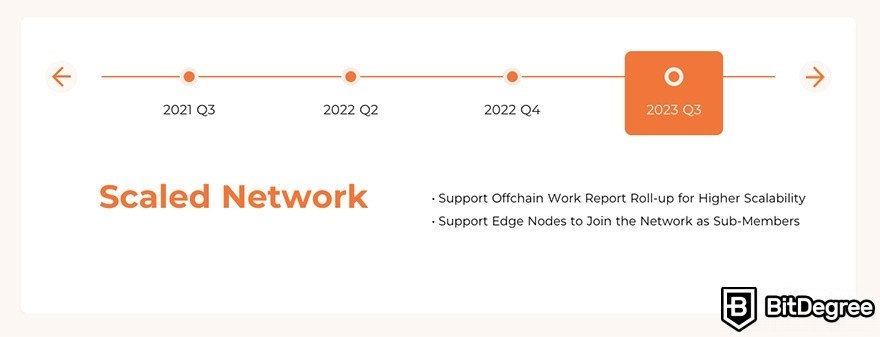
Even further down the line, Crust Network has plans for decentralized TEE attestations, network scaling, as well as creation of data management solutions for the Metaverse. That’s a lot!
In a general sense, reading through the various user Crust Network reviews left online, it would seem that the roadmap does inspire confidence in the project - that’s great!

Did you know?
All Crypto Exchanges may look similar to you but they're NOT all the same!
Crust Network Review: CONS
Up to this point in the Crust Network review, we’ve checked and covered some of the main benefits that you may expect to receive from using Crust, both from the standpoint of a simple crypto enthusiast, as well as a passionate Web 3.0 dApp developer.
Now, let’s swing things around, and talk about the less-ideal parts of this project.
Might be Too Complicated for Your Average Individual
Evidently, the biggest “con” that’s present with the Crust Network project isn’t even a con, so to speak. Instead, it’s the nature of the project, in general.
Crust aims to decentralize file storage and sharing - in theory, this seems like a pretty simple concept, at least if you’re familiar with the basics of DeFi and crypto, as a whole. However, when you start getting into the details, it soon becomes rather self-evident that the matter isn’t all that simple.
If you’re a crypto-savvy developer who has been launching NFT projects left and right, and are experienced with some advanced dApp development, then Crust shouldn’t pose any comprehension issues, whatsoever. That being said, developers aren’t the only people who can benefit from decentralized data storage and sharing.

The basics of Crust are pretty simple to understand. However, if you’re looking to start using the platform, and want to utilize its full potential, you’re going to need to be knowledgeable when it comes to concepts such as crypto wallets, the Ethereum token standards, Polkadot, IPFS, and more. It can be a lot to wrap your head around!
Do keep in mind that, as mentioned earlier in the Crust Network review, there’ll be a dedicated tutorial written on the project, too. If you’d like to learn how to use Crust, and all of its core features, you can find it here.
In summary, while it’s not technically a “con”, in of itself, it’s still something that should be kept in mind, if you’re planning to use Crust Network to its full potential. If you're looking for simpler functionality, you may also use Crust Files, as a beginner-friendly alternative.

- Secure and reliable
- Accepts fiat currencies
- Lots of trading options
- Reputable exchange
- Accepts fiat currencies
- Offers various trading options

- Huge trading variety
- Regulation-compliant around the globe
- Fair trading fees
- Beginner-friendly
- A wide array of features
- Vast number of different crypto coins & tokens

- Beginner-friendly
- Secure
- Decent trading and withdrawal fees
- Crypto.com Visa Card
- Automated tools & bots
- Ecosystem synergy with CRO
Conclusions
As I’ve mentioned in the introductory part of this Crust Network review, Crust is certainly one of the more-interesting Web 3.0-oriented projects to come out of the DeFi space, in recent years. No matter how you were to look at it, one thing’s for certain - it fills a specific niche, and offers a unique service to its users.
To be honest, it’s actually not even a “niche” service that Crust is offering, in the first place! Data storage and file sharing are two concepts that are important to a huge number of people, all around the world. A decentralized tool that would offer services in regards to both of those concepts can truly become a very valuable asset, no matter the context!
In of itself, Crust is a well-designed project. It utilizes advanced crypto technology, with tools such as Polkadot’s off-chain functionality and IPFS being at the forefront. On top of that, Crust Network’s service catalog will be useful to both individuals, as well as Web 3.0 developers.
The project has a dedicated wallet (Crust Wallet), as well as a native token called CRU. The token has actual, meaningful use cases, both in regards to things such as utility, as well as project governance, too. With the latter, Crust Network aims to achieve full DAO functionality.
The only bigger “negative” aspect associated with the Crust Network crypto project is the fact that it can be difficult to wrap your head around, if you have no prior experience with dApps and DeFi, in general. However, this isn’t a deal-breaking issue - not by a longshot. This is especially true when there are alternative approaches to Crust's functionality, such as that with Crust Files.
All in all, if you’re looking for a decentralized method of storing and sharing data, or want to develop a dApp without needing to worry about server management issues, make sure to check out Crust Network, and all that it has to offer!
The content published on this website is not aimed to give any kind of financial, investment, trading, or any other form of advice. BitDegree.org does not endorse or suggest you to buy, sell or hold any kind of cryptocurrency. Before making financial investment decisions, do consult your financial advisor.


